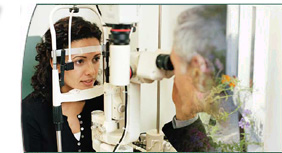-
Primary open-angle or chronic glaucoma :
This is the most common form of glaucoma. Damage to the
vision in this type of glaucoma is gradual and generally
painless. The affected person normally remains completely
unaware of the disease until the optic nerve is already
damaged badly which leads to decrease in the visual fields.
-
Closed angle or acute glaucoma : In this
type of glaucoma, the intra ocular pressure increases very
rapidly due to a sudden and severe block of fluid drainage
within the eye. Significant symptoms indicating the presence
of acute glaucoma appear suddenly. This condition has to be
treated immediately by an ophthalmologist otherwise blindness
may occur.
-
Other types of glaucoma are Congenital glaucoma,
Pigmentary glaucoma and Secondary
glaucoma.
-
All types of glaucoma are characterized by three common
features.
-
Increased intra ocular pressure: It has been
a cardinal sign of glaucoma. This is measured by tonometry
(Goldmann Application Tonometer, Schlitz tormenter etc.)
Increased IOP does not always requires treatment and normal
IOP does not always rules out glaucoma.
-
Cupping or Atrophy of the Optic Nerve: This
is the drying up of the optic nerve as a consequence to the
damage suffered because of high pressure in the eye. This
is assessed by examination of the Fundus of the eyes.
-
Visual Field Defects: This is basically the
presence of missing areas in the field of sight even though
the person may be seeing well otherwise. This condition is
measured on an instrument called the Perimeter.
The symptoms of Glaucoma
-
Glaucoma in early stages generally does not show any noticeable
symptoms. It is possible that a person suffering from chronic
glaucoma to be completely unaware of the disease. Chronic
(open angle) glaucoma generally progresses too slowly to get
noticed. Some common symptoms of chronic glaucoma could be:
-
Inability to adjust the eyes to darkened rooms such as theaters.
-
Subtle problems in ability to see in night.
-
Frequent changes (sooner than 6 months) in eyeglass (reading)
prescription.
-
Gradual
loss of peripheral vision.
In the case of Acute Glaucoma (Angle Closure) which
results from rapid increase in the Intra ocular pressure,
there could be severe symptoms. Common symptoms suggesting
the presence of acute glaucoma could be:
-
Blurred
vision.
-
Severe eye pain, facial pain.
-
Seeing rainbow colored halos around lights in the evenings.
-
Headaches.
-
Redness in the eye with sudden loss of vision.
-
Nausea and vomiting.
The high-risk groups who can get glaucoma
-
People belonging to families with a history of glaucoma.
-
People suffering from diabetes.
-
People having high minus or plus numbered glasses.
-
Everybody over forty years of age.
-
People suffering from hypertension.
-
Anybody who has undergone any kind of eye surgery.
-
People
with thyroid gland related ailments.
-
People with over mature cataracts.
-
People with any injury to the eye.
-
People with a history of prolonged use of steroid eye drops.
Is Glaucoma curable?
Glaucoma cannot be cured. But it can be controlled
and further damage to the optic nerve can be slowed down or
halted. This control can only be sustained through very disciplined
and regular treatment as advised by the ophthalmologist. It
is life long process.
What are the treatment options for Glaucoma?
(a) Medication (Eye drops) The chronic open angle variety
of glaucoma which has not progressed too far can be controlled
by the use of eye drops alone. These drops may have to be put
2-4 times a day. In case of higher intra ocular pressure, the
patient may have to use more than one type of eye drops.
(b) Laser treatment
Laser treatment is a must for acute type and angle
closure variety of glaucoma. Laser treatment is also done to
control pressure in open angle type glaucoma. Now a new technique
called ELT or Excimer Laser Trabeculotomy is also available
which helps in lowering the pressure with the help of a small
surgery.
(c) Surgery
In those cases where eye drops and laser treatment
do not prove sufficient to control the pressure, surgery is
done to create an alternate pathway for the fluid to drain out.
Must remember facts about Glaucoma.
Glaucoma is a symptom complex and as such there is no prevention
for development of glaucoma. It’s early detection and
prompt treatment can prevent deterioration of vision and blindness.
Here are few tips to be remembered:
-
Immediately get in touch with an eye specialist, if
you experience any of the following:
-
-
Sudden loss of vision.
-
Nausea and/or vomiting.
-
Poor night vision.
-
Persistent redness of the eye.
-
Frequent changes in reading glasses prescription.
-
If you are over forty and/or have a family history of glaucoma,
go for regular tonometry (intraocular pressure check-up).
-
There is no prevention of the development of glaucoma.
-
Sometimes the symptoms of glaucoma are simply not noticeable.
-
Glaucoma can silently snatch away your vision.
-
Timely detection of glaucoma is a must.
Timely treatment of glaucoma may prevent further loss of vision
and blindness.
REMEMBER !
Irregularity in the treatment schedule which is a lifelong
process may snatch away your ability to see and appreciate this
colorful and wonderful world despite your ophthalmologists best
efforts.





